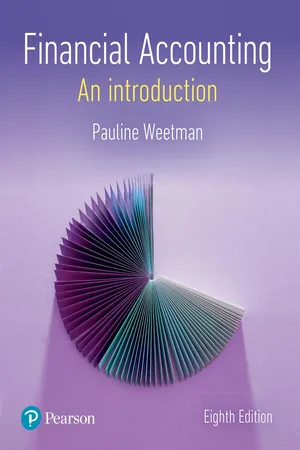
Financial Accounting
Pauline Weetman
- 544 pages
- English
- ePUB (mobile friendly)
- Available on iOS & Android
Financial Accounting
Pauline Weetman
About This Book
Gain a deeper understanding of the Financial Accounting principles with a leading text written by an expert in the field.
Financial Accounting, 8 th edition by Pauline Weetman, is a core textbook written by an expert teacher in the field that will offer you the resources you need to explore and acquire a deeper understanding of a wide range of concepts around the discipline.
This text is ideal for undergraduates in Business Studies degrees, Undergraduates in Accounting courses, students studying Accounting for MBA and Postgraduate courses, and Professional courses introducing Accounting for the first time.
This edition focuses on retaining all the features that have contributed to its popularity, including accounting equations, a clear and accessible writing style, a range of student activities throughout the book, and the extensive use of real-world case studies, offering you a deeper understanding of the topics.
Key features:
- Definitions and terminology aligned with the 2018 IASB Conceptual Framework.
- Fully up-to-date with the International Financial Reporting Standards (IFRS).
- New case studies provide examples from real-world companies.
- Activities aligned to each chapter section, encouraging students to explore and consider issues from different angles.
- Experience-driven conversations throughout the book between two managers expanded for this edition and updated with an even greater practical emphasis.
- Extensive coverage of fair value is provided throughout the text.
- Exploration of the Strategic Report and Directors' Report.
- Focus on specific knowledge outcomes with end-of-chapter self-evaluations.
- Questions testing your understanding are graded according to difficulty.
With a strong emphasis on the 2018 Conceptual Framework of the International Accounting Standards Board, this text is an essential resource that will guide you through the 'whys' and not just the'whats' of Financial Accounting.
Frequently asked questions
Part 1
A conceptual framework: setting the scene
Chapter 1
Who needs accounting?
Real World Case
Oxfam: meeting users’ needs
Extracts from Annual Report and Accounts
Purpose and charitable objects
- to prevent and relieve poverty and to protect vulnerable people, including through humanitarian intervention;
- to advance sustainable development;
- to promote human rights, equality and diversity, in particular where to do so contributes to the prevention and relief of poverty;
- in all cases working anywhere in the world.

Highlights (page 10)
How do we judge the impact of our work?
- reporting data on the numbers of people and communities reached by our programmes
- completing review exercises to understand – and speak about – our outcome achievements as well as our challenges, and how we deal with them
- undertaking evaluations to assess our overall strategies, test the core assumptions about how we contribute to social change, and assess our effectiveness in different contexts
- consulting with key stakeholders to gather their insights and assessments about our overall efforts.
Accounting conventions (page 38)
Discussion points
- Who might be included in the stakeholders to whom Oxfam is accountable?
- To what extent do the ‘Highlights’ meet the information needs of users of the annual report?
Contents
| 1.1 | Introduction | |
| 1.2 | The development of a conceptual framework | |
| 1.3 | The Conceptual Framework for Financial Reporting | |
| 1.4 | Types of business entity | |
| 1.4.1 | Sole trader | |
| 1.4.2 | Partnership | |
| 1.4.3 | Limited liability company | |
| 1.4.4 | Limited liability partnership | |
| 1.4.5 | Comparing partnership and limited liability company | |
| 1.5 | Users and their information needs | |
| 1.5.1 | Management | |
| 1.5.2 | Owners as investors | |
| 1.5.3 | Lenders | |
| 1.5.4 | Suppliers and other trade creditors | |
| 1.5.5 | Employees | |
| 1.5.6 | Customers | |
| 1.5.7 | Governments and their agencies | |
| 1.5.8 | Public interest | |
| 1.6 | Financial statements | |
| 1.6.1 | General purpose or specific purpose financial statements? | |
| 1.6.2 | Stewards and agents | |
| 1.6.3 | Who needs financial statements? | |
| 1.7 | Summary | |
| Supplement: Introduction to the terminology of business transactions | ||
Learning outcomes
- Define, and explain the definition of, accounting.
- Explain what is meant by a conceptual framework.
- Explain the distinguishing features of a sole trader, a partnership and a limited company.
- List the main users of financial information and their particular needs.
- Discuss the usefulness of financial statements to the main users.
- Define the basic terminology of business transactions.
1.1 Introduction
Definition
- What is the process?
- How is financial information identified?
- How is financial information measured?
- How is financial information communicated?
- What is an entity?
- Who are the users of financial information about an entity?
- What types of judgements and decisions do these users make?
Table of contents
- Cover
- Title page
- Contents in brief
- Contents
- Preface to the eighth edition
- Publisher’s acknowledgements
- Financial accounting
- Part 1 A conceptual framework: setting the scene
- Part 2 Reporting the transactions of a business
- Part 3 Recognition in financial statements
- Part 4 Analysis and issues in reporting
- Financial accounting terms defined
- I Information extracted from annual report of Safe and Sure Group plc, used throughout Financial Accounting
- II Solutions to numerical and technical questions in Financial Accounting
- Index
- Imprint